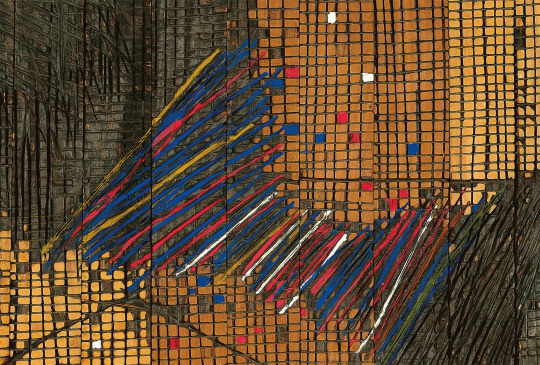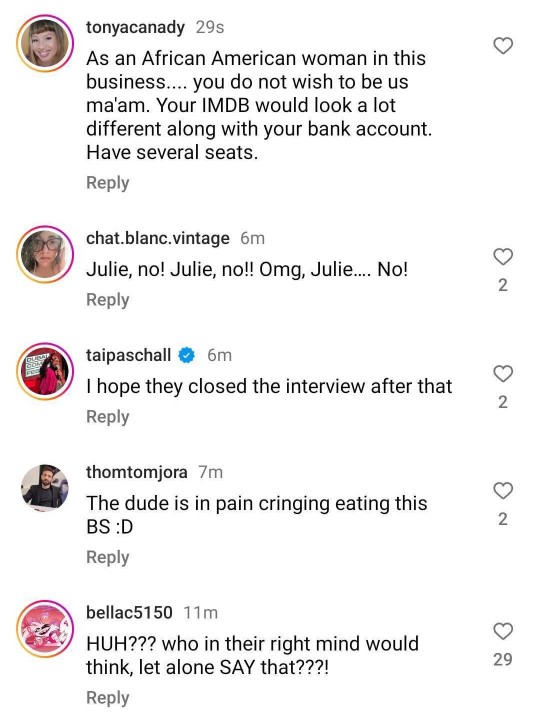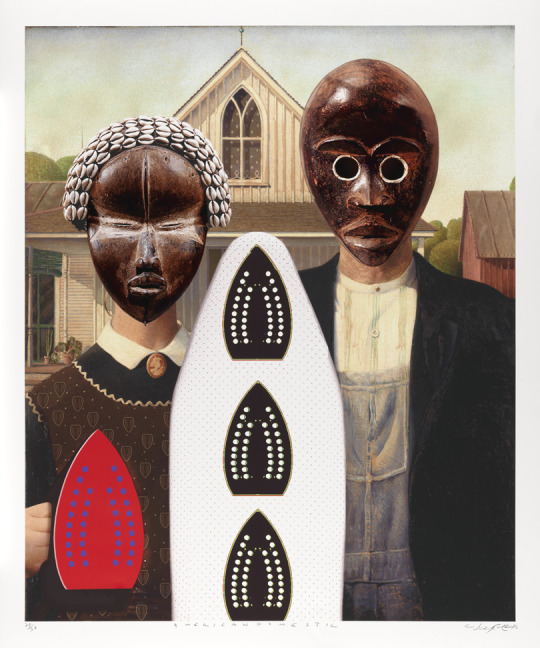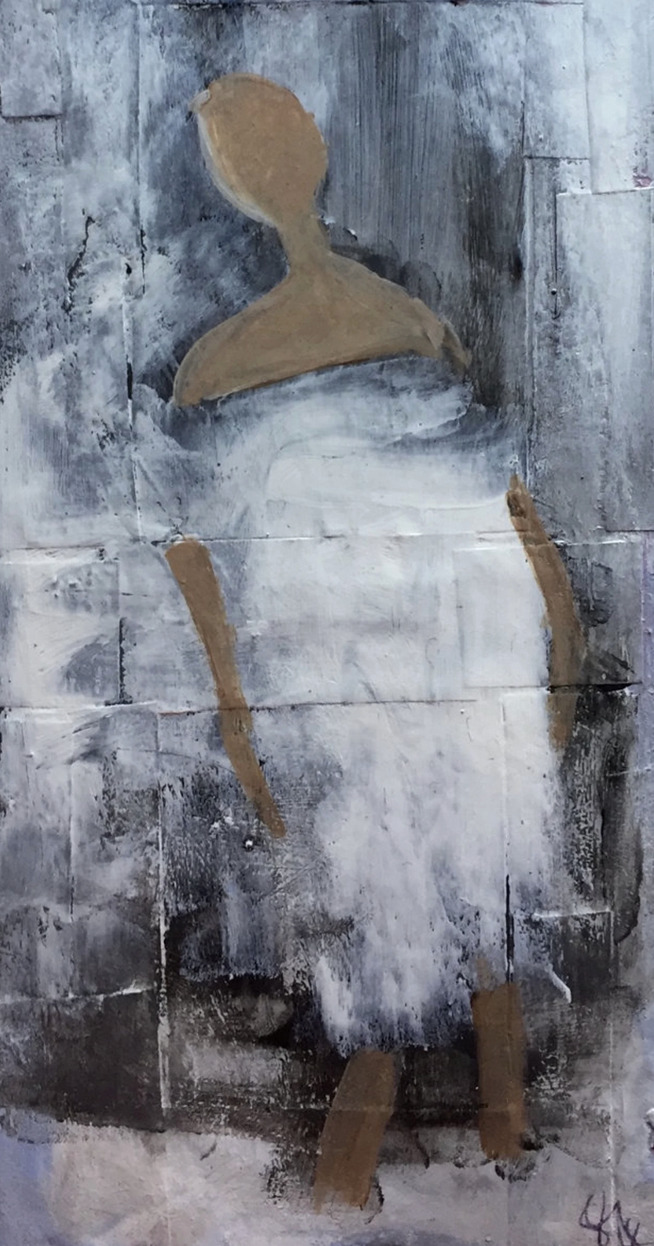#African American media
Text

Sabado por la Noche (Saturday Night), Jean-Michel Basquiat, 1984
Acrylic, silkscreen and paper collage on canvas
77 x 88 in. (195.6 x 223.5 cm)
#art#painting#jean michel basquiat#contemporary art#neo expressionism#20th century art#black artists#1980s#artists of color#20th century#acrylic#silkscreen#collage#mixed media#american#african american#red
125 notes
·
View notes
Text














Anti-literacy laws in many slave states before and during the American Civil War affected slaves, freedmen, and in some cases all people of color. Some laws arose from concerns that literate slaves could forge the documents required to escape to a free state. According to William M. Banks, "Many slaves who learned to write did indeed achieve freedom by this method. The wanted posters for runaways often mentioned whether the escapee could write." Anti-literacy laws also arose from fears of slave insurrection, particularly around the time of abolitionist David Walker's 1829 publication of Appeal to the Colored Citizens of the World, which openly advocated rebellion, and Nat Turner's Rebellion of 1831.
The United States is the only country known to have had anti-literacy laws.


Significant anti-African laws include:
1829, Georgia: Prohibited teaching Africans to read, punished by fine and imprisonment
1830, Louisiana, North Carolina: passes law punishing anyone teaching Africans to read with fines, imprisonment or floggings
1832, Alabama and Virginia: Prohibited Europeans from teaching Africans to read or write, punished by fines and floggings
1833, Georgia: Prohibited Africans from working in reading or writing jobs (via an employment law), and prohibited teaching Africans, punished by fines and whippings (via an anti-literacy law)
1847, Missouri: Prohibited assembling or teaching slaves to read or write
Mississippi state law required a white person to serve up to a year in prison as "penalty for teaching a slave to read."
A 19th-century Virginia law specified: "[E]very assemblage of negroes for the purpose of instruction in reading or writing, or in the night time for any purpose, shall be an unlawful assembly. Any justice may issue his warrant to any office or other person, requiring him to enter any place where such assemblage may be, and seize any negro therein; and he, or any other justice, may order such negro to be punished with stripes."
In North Carolina, African people who disobeyed the law were sentenced to whipping while whites received a fine, jail time, or both.
AME Bishop William Henry Heard remembered from his enslaved childhood in Georgia that any slave caught writing "suffered the penalty of having his forefinger cut from his right hand." Other formerly enslaved people had similar memories of disfigurement and severe punishments for reading and writing.
Arkansas, Kentucky, and Tennessee were the only three slave states that did not enact a legal prohibition on educating slaves.
It is estimated that only 5% to 10% of enslaved African Americans became literate, to some degree, before the American Civil War

#afrakan#african#kemetic dreams#brownskin#afrakans#african culture#africans#brown skin#afrakan spirituality#anti literacy#media literacy#financial literacy#digital literacy#information literacy#early literacy#ban books#ban#united states#united states of america#geopolitics#america#usa#politics#slavery#prison abolition#abolition#american history#african american history#civil rights
71 notes
·
View notes
Video
youtube
A Black Women’s History of Hoodoo, Conjure, & Witchcraft by Intelexual Media
#youtube#intelexual media#black history#african american spirituality#hoodoo#voodoo#conjure#rootwork
65 notes
·
View notes
Text

El Anatsui, Earth-Moon Connexions, (wood, tempera), 1993 [National Museum of African Art, Smithsonian Institution, Washington, DC. © El Anatsui]


#art#mixed media#assemblage#geometry#pattern#structure#el anatsui#national museum of african american history and culture#smithsonian institution#1990s
42 notes
·
View notes
Text
instagram
#politics#us politics#democrats are corrupt#democrats will destroy america#wake up democrats!!#elizabeth warren#kamala harris#indian#lib dems#liberalism is a mental disorder#liberal media#fake red indian#fake African American#liberal incompetence#Instagram
10 notes
·
View notes
Text



the idiocy is killing kieran lmaooo
#white people being white people#white french people being usual racist selves#kieran culkin#julie delpy#sundance film festival#wiener-dog#cringe#uncomfortable#african american#oscars#academy#diversity#inclusion#racial insensitivity#cultural awareness#social media backlash#entertainment industry#racial remarks#sensitivity training
13 notes
·
View notes
Text
How 'Evil' Teaches a Masterclass in 'Show, Don't Tell' Through Racial Inequality
Evil TV show, C for COP episode, racial inequality, show don't tell writing, storytelling techniques, police bias, impactful TV episodes, African American representation, writing lessons from TV, media portrayal of racism
Learn more about the show: https://www.paramountplus.com/shows/evil/
Transcript
So I am watching this show evil. And, and I was talking to my husband about this last episode that we saw, and that it does a great job of showing the theme that it wants to focus on during the episode. And I think I took that as a great writing lesson. Because oftentimes, as authors, we are asked to show and not…
#African American representation#C for COP episode#Evil TV show#impactful TV episodes#media portrayal of racism#police bias#racial inequality#show don&039;t tell writing#storytelling techniques#writing lessons from TV
7 notes
·
View notes
Text
i do feel african americans & americans as a whole share this thing that heavily influences the perception of the "black experience" or "black representation" in canada and even just in media where it’s like. when they speak of the black experience, they speak of the african american experience. when they speak of black representation, they speak of african american representation. even if it isn’t explicitly called that, i think that’s somehow become the standard bc of this weird obsession with generalization. african immigrants share very little experience wise with african americans. or african canadians or whatever.
african immigrants don’t see race the same way african americans do because like racism often was not a problem in our countries. colorism yeah classism yes etc etc but when it comes down to it, most of us are immigrants then our nationalities before we are black. visa status changes a lot & background makes for a very varied experience from african americans. it’s like...i, personally, tend to gravitate towards other immigrants more than other black people, because i have found that except for looks, i have nothing in common with these kids. absolutely nothing.
we don’t view the world the same, we don’t have the same background, & (this is a big one) this is their home and it is not mine. they are black first & foremost and while i know that’s how i’m viewed in canada & the west as a whole, that isn’t what i am. i relate more to immigrant characters than black ones because black characters in western media or popular media are often african american, even if that isn’t the intention, because that has become the view of "black culture".
i’m not saying that african americans aren’t black or their experiences aren’t valid or they don’t have their own culture that they don’t experience a unique struggle. but their struggle is not the universal black one especially for those that do not live in the west & neither is their culture shared across board.
also i am speaking on my experiences as an african immigrant & an african and that i’ve seen of others like me. my experience is definitely not universal, hardly anyone's is, but it is common.
#mine#whoo boy. ❤️#i am not trying to say they don’t deserve to see themselves represented & i apologize if that’s how it comes across#but what i am saying is they aren’t the only black group that should be represented and it is a problem that it’s what’s happening.#the problem is not & never will be that african americans are getting represented#because they deserve to see themselves in media and even their representation is lacking and often harmful.
16 notes
·
View notes
Text
Trump supporters are trying to blur Trump's racism by posting fake AI images of him being the object of adoration by African Americans.
One of the disseminators of such images is a white MAGA talk show host in Florida.
Unlike in 2016, when there was evidence of foreign influence campaigns, the AI-generated images found by the BBC appear to have been made and shared by US voters themselves.
One of them was Mark Kaye and his team at a conservative radio show in Florida.
They created an image of Mr Trump smiling with his arms around a group of black women at a party and shared it on Facebook, where Mr Kaye has more than one million followers.
At first it looks real, but on closer inspection everyone's skin is a little too shiny and there are missing fingers on people's hands - some tell-tale signs of AI-created images.
"I'm not a photojournalist," Mr Kaye tells me from his radio studio.
"I'm not out there taking pictures of what's really happening. I'm a storyteller."
He had posted an article about black voters supporting Mr Trump and attached this image to it, giving the impression that these people all support the former president's run for the White House.
In the comments on Facebook, several users appeared to believe the AI image was real.
"I'm not claiming it is accurate. I'm not saying, 'Hey, look, Donald Trump was at this party with all of these African American voters. Look how much they love him!'" he said.
"If anybody's voting one way or another because of one photo they see on a Facebook page, that's a problem with that person, not with the post itself."
Basically, Mark Kaye is telling the BBC that he has the right to deceive people.
Another spreader of fake images is a Christian fundamentalist known as "Shaggy" in Michigan.
We tracked down the person behind the account called Shaggy, who is a committed Trump supporter living in Michigan.
"[My posts] have attracted thousands of wonderful kind-hearted Christian followers," he said in messages sent to the BBC on social media.
When I tried to question him on the AI-generated image he blocked me. His post has had over 1.3 million views, according to the social media site X. Some users called it out, but others seemed to have believed the image was real.
FYI: This is "Shaggy". Is anybody shocked that the people spreading these fake images of blacks are old white MAGA zombies?

Apparently there are still people using oligarch Elon Musk's Twitter X. Don't expect Odious Elon to do anything about obvious attempts to deceive users.
Cliff Albright, the co-founder of campaign group Black Voters Matter, said there appeared to be a resurgence of disinformation tactics targeting the black community, as in the 2020 election.
"There have been documented attempts to target disinformation to black communities again, especially younger black voters," he said.
If Trump supporters think that they have the right to spread bogus images, we then have the right to have some fun with them. 😋

#african americans#donald trump#fake images#disinformation#fake news#poor ai distortions#mark kaye#MAGAShaggy1958#maga zombies#social media#deceiving black voters#republicans#cliff albright#black voters matter#election 2024#vote blue no matter who
12 notes
·
View notes
Text
Wanted to watch The Snoopy Show while I was high and ep.1 has a joke about Snoopy being in the French foreign legion.
As Omar Sakr wrote: "Even in this cartoon world / There is a desert full of dogs / Soldiers and guns, and somewhere / Out of frame, Arabs being put down."
#kinda shocked because the 40 minute special about Franklin was very aware of its portrayal of an african american child#and then the Tv show was like. 'casually mentions snoopy being in the FFL like that doesn't suggest some very bad things'#and i know it's not that deep but im making it that deep because im tired. if youre going to involve the military in media#i want you to have a damn good reason for it or i want you to gtfo
9 notes
·
View notes
Text
I'm trying not to block people. But there's only so many times I can go 'give people the benefit of the doubt' and then click their blog and what's literally the third or fourth post on their blogs? They talk about middle eastern people like savages who can't control their violent urges. And of course, more than half of them are Americans. After posing for 20 years, the masks that temporarily went up when anti-war activists criticised the American war in the Middle East are slipping, some of you never really believed brown people to be your equals did you? Get the fuck off my blog.
#it's infuriating to watch. American voices drowning out everything el. American opinions rule everything. American politics shapes the world#shut the fuck up; you live in Cincinnati OH USA. This will not affect you like the people in countries you cannot point on the map#an honorary citizenship doesn't change that#every time the US talks it's so loud that it automatically becomes default opinion because (as we have covered countless times before)#any and all events elsewhere are framed in world media as 'how does this affect the US' or 'what does the US think of this?'#and that's how we get shit like 'US vetos at UN' being talked about more than 'all countries EXCEPT the US voted for a ceasefire in the UN'#(for which an American zionist blocked me: why should an American's opinion on this be most important?)#rant#give me strength; I go outside and people are way more even-headed but my god online it's awful#some day the west will treat everyone else as important and not just because they import (/steal) natural resources from there#or that the US has a strategic military base there#(e.g.: imports: the reason the US doesn't fuck with China too much.#geographical proximity to China and Russia: the reason why the US wants an ally in India#military outpost to the middle east: Israel. Raw materials: african nations. You get me?)#though it's insane how far they're going to defend Israel rn; they'd have dropped any other ally of convenience by this point
8 notes
·
View notes
Text

By Any Other Name, Janet Taylor Pickett, 2020
Acrylic and printed paper collage on canvas
40 x 60 in. (101.6 x 152.4 cm)
#art#painting#janet taylor pickett#contemporary art#black artists#women artists#collage#female artists#artists of color#2020s#21st century#21st century art#acrylic#mixed media#american#african american
63 notes
·
View notes
Text

Betye Saar
Window
1966
#betye saar#modern art#american art#assemblage#collage#mixed media#black artist#african american art#african american artists#african american art history#american art history#art history#1960s art#1960s aesthetic#1960s#the 60s#window#contemporary art#hands
21 notes
·
View notes
Link
The Allen Media Group (AMG) free-streaming digital platform HBCU GO – the leading media provider for the nation’s 107 Historically Black Colleges and Universities (HBCUs) – is proud to announce the 2024 football season schedule.
3 notes
·
View notes
Text

Willie Cole, “American Domestic”, 2016, Digital Print

(Tom Laidman, “Broadway”, 1993 and “Bois Ma Petite”, 1999, Lithograph on paper)
Currently on view at Akron Museum of Art is RETOLD: African American Art and Folklore, a collection of art from the Wesley and Missy Cochran collection, organized into themes exploring aspects of African American history and culture. The show features many well known and lesser known artists including Amiri Baraka, Beverly Buchanan, Willie Cole, Trenton Doyle Hancock, William Pope.L., Tom Laidman, Jacob Lawrence, Alison Saar and more.
From the museum about the exhibition-
African folklore has been around as long as humankind, and the African diaspora in America has added new dimensions to its rich history. African American folk stories teach about culture, the mysteries of life, and the survival of a race of people bought and sold who continue to thrive in an unjust society.
“RETOLD: African American Art and Folklore” focuses on four themes: Remembering, Religion, Racialization, and Resistance. These themes provide a comprehensive retelling of the works featured in the exhibition. In many of the pieces, the artist’s muse connects closely with stories that have been told generation after generation. Folklore texts are featured throughout the space as a means to retell a richer, deeper story of African American culture.
There are more than forty artists represented in this exhibition, all holding one similar truth: their story of joy and struggle in the African American experience.
In addition to the artwork, there is also an educational video produced by Josh Toussaint-Strauss of The Guardian that explores the misconceptions about Haitian Voudou that is worth a watch.
youtube
How ‘voodoo’ became a metaphor for evil
#Akron Art Museum#Willie Cole#Tom Laidman#African American History#Akron Art Shows#Alison Saar#Amiri Baraka#Art#Art Shows#Beverly Buchanan#Collage#Drawing#Film and Video#Jacob Lawrence#Josh Toussaint-Strauss#Mixed Media#Mixed Media Art#Ohio Art Shows#Painting#Photography#Pope L.#Printmaking#Prints#Sculpture#Trenton Doyle Hancock#Vodou#Voodoo#William Pope.L#Youtube
3 notes
·
View notes
Text



It was wonderful sharing my mixed media paintings at the Gulf Breeze (FL) Celebrates the Arts festival this past weekend. I have prints left. There are 43 pieces altogether in this series. See some in my Etsy shop.
#Sharony Green#art#paintings#mixed media#african american artist#african american art#woman artist#woman artwork
2 notes
·
View notes